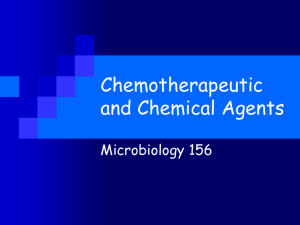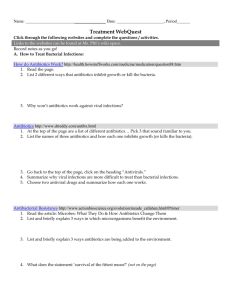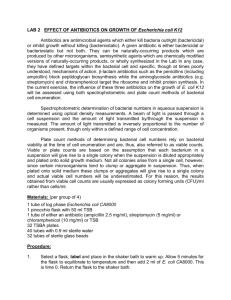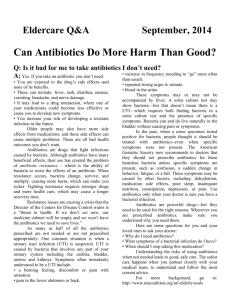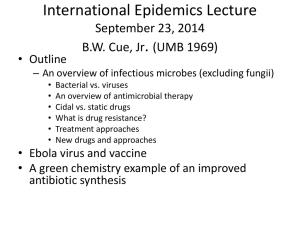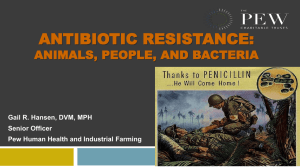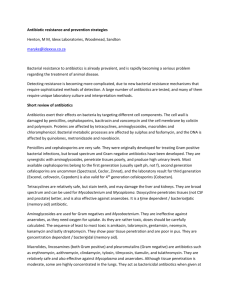Activity 1.4
advertisement
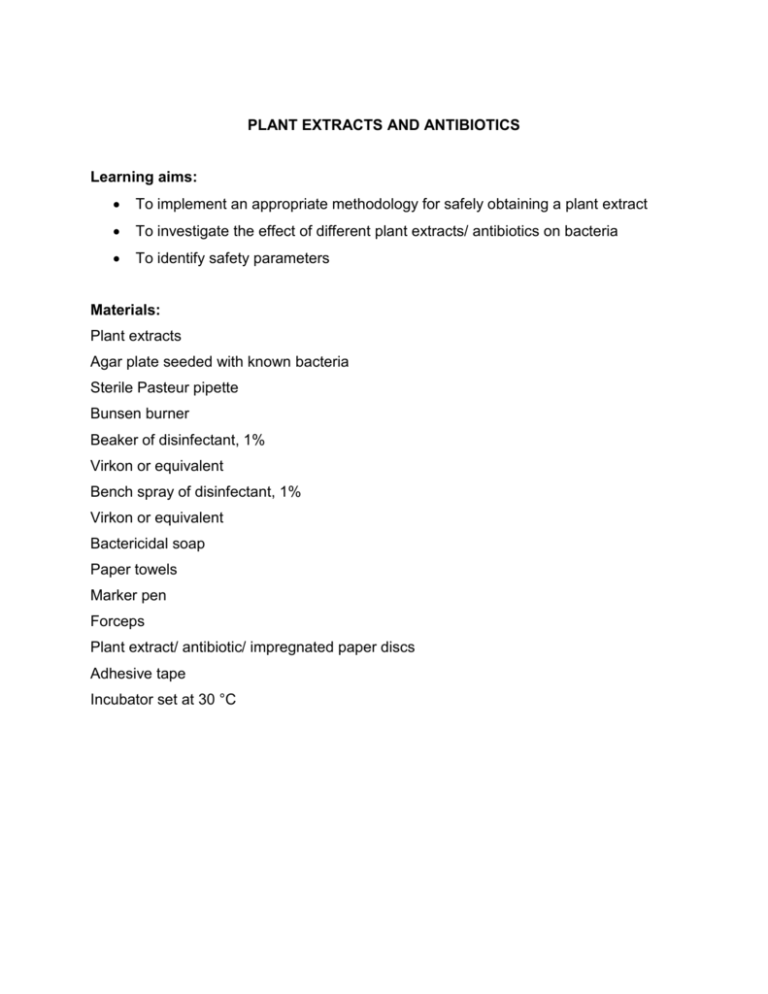
PLANT EXTRACTS AND ANTIBIOTICS Learning aims: To implement an appropriate methodology for safely obtaining a plant extract To investigate the effect of different plant extracts/ antibiotics on bacteria To identify safety parameters Materials: Plant extracts Agar plate seeded with known bacteria Sterile Pasteur pipette Bunsen burner Beaker of disinfectant, 1% Virkon or equivalent Bench spray of disinfectant, 1% Virkon or equivalent Bactericidal soap Paper towels Marker pen Forceps Plant extract/ antibiotic/ impregnated paper discs Adhesive tape Incubator set at 30 °C Even though pharmacological industries have produced a number of new antibiotics in the last three decades, resistance to these drugs by microorganisms has increased. In general, bacteria have the genetic ability to transmit and acquire resistance to drugs, which are utilized as therapeutic agents. Such a fact is a cause for concern. Therefore, actions must be taken to control the use of antibiotic, develop research to better understand the genetic mechanisms of resistance, and to continue studies to develop new drugs, either synthetic or natural. The ultimate goal is to offer appropriate and efficient antimicrobial drugs to the patient. According to World Health Organization, medicinal plants would be the best source to obtain a variety of drugs. About 80% of individuals from developed countries use traditional medicine, which has compounds derived from medicinal plants. Therefore, such plants should be investigated to better understand their properties, safety and efficiency. In Argentina, a research tested 122 known plant species used for therapeutic treatments. It was documented that among the compounds extracted from these plants, twelve inhibited the growth of Staphylococus aureus, ten inhibited Escherichia coli, and four inhibited Aspergillus niger and also reported that the most potent compound was one extracted from Tabebuia impetiginosa. Hence, more studies pertaining to the use of plants as therapeutic agents should be emphasized, especially those related to the control of antibiotic resistant microbes. Exercise 1 Extraction Methods Inquire about the methodology of preparing safely plant extracts from a plant that they have discovered in their local ecosystem . Exercise 2 Test the effectiveness of several types of plant extract/ antibiotics/, which they have produced from plants selected from their local ecosystem,. on bacteria The standard method of doing this is to put discs of blotting paper soaked in the various extracts / and control antibiotics onto an agar plate that has been inoculated with the bacteria. Question Inquire about the safety parameters that they need to apply during this investigation. Safety is an important aspect of this experiment and guidance on microbiology safety is essential. Investigate the following considerations: Eye protection. Pathogenic microorganisms Aseptic techniques Antibacterial disinfectant Allergic reactions First aid Exercise 3 Perform an experiment, which investigates the effect of different types of antibiotic/ plant extracts (the independent variable) on bacteria. Include details of a suitable dependent variable and how it can be measured. Methodology 1. Wash your hands with the bactericidal soap. Spray the working area thoroughly with the disinfectant spray and wipe with a paper towel after waiting for the disinfectant to act (10 minutes with Virkon, longer with other disinfectants). 2. Prepare an agar plate seeded with bacteria. This may have already been done for you. Label the Petri dish on the base at the edge with your name, the date, and the type of bacterium it is inoculated with. 3. If not already autoclaved, sterilise the forceps by flaming them and allow to cool. Use them to pick up a plant extract / antibiotic disc. Raise the lid of the Petri dish and place the plant extract impregnated paper disc firmly in the centre of the agar; if individual discs are used they will need to be spaced evenly around the dish. 4. Tape the dish securely with two pieces of adhesive tape (but do not seal it completely), then incubate it upside down for 48 hours at 30 °C. 5. Wash your hands with bactericidal soap and clean the bench again using the Virkon spray. 6. After incubation, look carefully at the plate but do not open it. Where bacteria have grown, the plate will look opaque, but where the antibiotics have inhibited growth, clear areas called inhibition zones will be seen. Measure the diameter of the inhibition zones in millimetres and use this information to decide which antibiotic is most effective at inhibiting the growth of the bacterium. A clear area where the bacterial growth has been inhibited should surround each of the discs. The simplest measurement would be to use a ruler and measure the diameter of the cleared area. It is straightforward to compare the results of different treatments if the clear areas are perfect circles. If the diameter varies, one possibility is to measure at the widest point. For a more precise measurement, the area of the clear zone would have to be determined. Students may suggest possible ways of doing this. 7. Collect data from other members of the class who used the other bacterial cultures. 8. Write a brief report of the results, comparing the different antibiotics, and the effects on the different bacterial cultures. Do some research to find out a bit more about the antibiotics that were effective against the bacterium you used. Questions 1. What factors determine the diameter of the inhibition zones? 2. Suggest how named variables you have could be controlled. 3. Discuss the reliability and validity of the experiment

